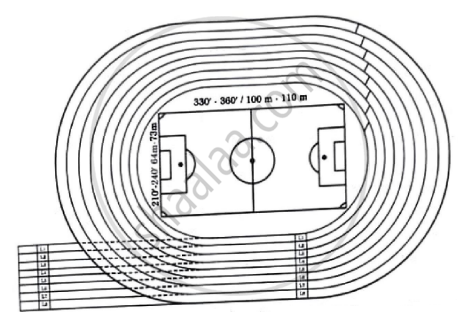Advertisements
Advertisements
Question
|
In order to organise, Annual sports Day, a school prepared an eight-lane running track with an integrated football field inside the track area as shown below:
The length of innermost lane of the track is 400 m and each subsequent lane is 7.6 m longer than the preceding lane. Based on given information, answer the following questions, using concept of Arithmetic Progression. |
- What is the length of the 6th lane? [1]
- How long is the 8th lane than that of 4th lane? [1]
- While practicing for a race, a student took one round each in first six lanes. Find the total distance covered by the student. [2]
OR - A student took one round each in lane 4 to lane 8. Find the total distance covered by the student. [2]
- While practicing for a race, a student took one round each in first six lanes. Find the total distance covered by the student. [2]
Solution
i. an = a + (n − 1)d
For the 6th lane (n = 6):
a6 = 400 + (6 − 1) × 7.6
= 400 + 5 × 7.6
= 400 + 38
= 438 m
So, the length of the 6th lane is 438 m.
ii. For the 8th lane (n = 8):
a8 = 400 + (8 − 1) × 7.6
= 400 + 7 × 7.6
= 400 + 53.2
= 453.2 m
For the 4th lane (n = 4):
a4 = 400 + (4 − 1) × 7.6
= 400 + 3 × 7.6
= 400 + 22.8
= 422.8 m
Difference:
453.2 − 422.8
= 30.4 m
So, the 8th lane is 30.4 m longer than the 4th lane.
iii. (a) Sn = `n/2[2a + (n - 1)d]`
For n = 6
S6 = `6/2[2(400) + (6 - 1)×7.6]`
= 3[800 + 38]
= 3 × 838
= 2514 m
So, the total distance covered by the student is 2514 m.
OR
iii. (b) We sum the terms from 4th lane to 8th lane.
Using the sum formula for n terms, where a4 to a8 are considered:
Sn = `n/2[2a+(n-1)d]`
Here, n = 5 (as we consider lanes 4, 5, 6, 7, and 8).
S5 = `5/2[2(422.8)+(5-1)xx7.6]`
= `5/2[845.6+30.4]`
= `5/2xx876`
= `4380/2`
= 2190 m
So, the total distance covered by the student is 2190 m.

